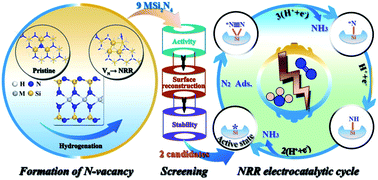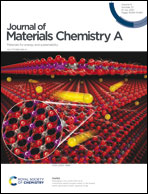Screening of effective NRR electrocatalysts among the Si-based MSi2N4 (M = Ti, Zr, Hf, V, Nb, Ta, Cr, Mo, and W) monolayers†
Abstract
Recently, Science reported a novel centimeter-scale monolayer film of MoSi2N4 synthesized by the chemical vapor deposition method (Science, 2020, 369, 670). Since Si atom has been recognized to be an active phase for N2 fixation, in this paper, we systematically evaluate the catalytic performance in the electrochemical N2 reduction reaction (NRR) on a series of MSi2N4 (M = Ti, Zr, Hf, V, Nb, Ta, Cr, Mo, and W) monolayers, by means of density functional theory calculations. It is found that the N vacancy, which should be firstly created to expose the active Si atoms, is more favorably formed on a pre-hydrogenated surface. Through a three-step screening, TiSi2N4 and TaSi2N4 monolayers are predicted to be highly potential and promising electrocatalysts because they can (i) successfully capture N2, (ii) effectively recover to the initial active states after a round of catalytic cycle without a strong surface reconstruction, and (iii) be stabilized at high temperatures. Moreover, thorough NRR mechanism investigations show that the NRR process proceeds via a Mars–van Krevelen mechanism, where the calculated limiting potentials are only −0.41 and −0.46 V for TiSi2N4 and TaSi2N4, respectively.



 Please wait while we load your content...
Please wait while we load your content...